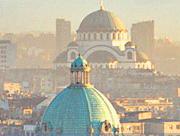Bujanovac Chronicles: Finding Snow in Southern Serbia

Rakovac, Southern Serbia
Snow has a supremely deft, crystalline structure. It hangs heavily to the point of being hardened lead. It lingers softly like a passing kiss. It gathers slowly like an age that may never pass. It can also accelerate like a lethal storm. In a day, you can experience all forms – though rarely.
Today, in Bujanovacs, a usually untidy, muddy town of noise, smells and inventive parking, one could experience all manner of snow. It was an apt Orthodox Christmas Eve present. First came the teasing crystals, the pattering of them melting before the breath of residents as they mulled about the town. Then, the cold breeze wafting through, a cleansing air that chilled the unprotected skin. Following that, pellets of snow that seemed to resemble Hollywood film projections, icing pathways and forming dandruff-like presences on surfaces. Finally, the romantic finale – the caressing, seductive snow that buries if not respected.
In the Serbian south, the snow has a chance to work its magic. It gathers to render the environment pristine, a form of environmental make-up over rough and ready surfaces. Rough maidens become glacial beauties, the landscape an icing sugar wonderland. In Bujanovac, a town that retains its deep Turkish flavour, the mud vanishes under the aesthetically drawn white carpet. There is no suggestion that this is a town of healing springs and palliative bliss against rheumatism – the investors and entrepreneurs remain aloof from the region, retaining their cash for projects for the northern part of the country – if that.
Incomplete houses, with brick and structure staring at passing walkers, dot the neighbouring village of Rakovacs. They resemble humorous constructions of an ill mind, a polka dot chaos. A house showing a poorly scribbled “for sale” sign (na prodaju), is distinctly incomplete, a skeleton that may, or may not be finished, depending on the financing of the individual. Other houses feature long, gorgeous lines of hot peppers, sensuously garlanded like protective pieces to ward off illness. It does not matter how incomplete a house may be – the peppers shall have their stand even as the snow lingers.
Roads become treacherous ice ways, where walkers risk doing themselves injury at an unanticipated slip, an embarrassing conclusion to the Christmas celebration. The body and ice do not react well on contact, the meeting going wrong with a ruptured bone as local residents may pass by.
The rugged Albanian and Serb faces seem sharply drawn against the snow, which reflects the winter sun with searing effect. There are traces of the previous night’s activities in the village centre of Rakovacs, both sombre and frolicsome – the sacrificed oak trees burned for the occasion of Orthodox Christmas, the slight smell of cooked rakija, the Serb variant of brandy. The dances, held with ceremonial relish, have also left their prints.
The bold chaffinches are feasting on the remains, finding nibbles from the night before, and any stray items that come their hungry way. Their red hue striped by black lines is animated by the sun, and their chirping assumes an even more aggressive form in the need to find food in the cold.
Stray dogs keep company, or in some cases irritate, the walkers as they venture through the villages. They seem like nature’s guardians, a reminder of the skill and genius they initially exhibited in convincing agrarian civilisations to adopt them. They are of no distinct breed, but are characters of power and presence, truly giving picture to the idea of a “dog eat dog” world. Their world is one of furry tribes and rivals, where ruthlessness and hostility are total.
The difference between these canines lies in whether the lot of a chained animal in closed quarters is better off than the freelancer hound which hunts for scraps and steals the quarry in the concealing snow. Mimi, a bobbish beast barking enthusiastically to any who pass her fence, is one such example. She wags her fluffy tail, and has a heart of gold, or some sort. She will kill if required. In other cases, such an animal probably has the knowledge that food and water on tap will prove to be reliable. Forget, however, the comforts of walking and freely granted mobility.
The other beasts, by way of contrast, can move with liberal dispensation, striking any food supply when needed, explore the hinterland if necessary. The problem there is the precariousness of nature. It is ruthless – and there are always other canines to put their fellow animals down the pecking order.
On this occasion, a mongrel breed of some beauty lopes along, setting her teeth in playful, even tender manner, into the hands willing to caress her. Her companion, a fifth of her size, is the Sancho Panza to her foolhardy Don Quixote. The former, a face of pug-like reminder, is the wiser one, retreating in the face of other stray dogs, knowing the odds in the manner her dirty yellow companion has no clue about.
Time, after the Christmas stroll, to enter the family home, to warm up in the presence of an uncompromising wood stove, in a temperature that would give a good challenge to countries on the equator. The dogs can still be heard outside, their yapping carrying over the snow. The snow lingers in its beauty, resisting change – till the temperature drops. Then, the mud will reappear, the fearful slush will slosh, and the noise and smells shall assume their positions. Little Istanbul shall revive.
Dr. Binoy Kampmark was a Commonwealth Scholar at Selwyn College, Cambridge. He lectures at RMIT University, Melbourne. Email: [email protected]

